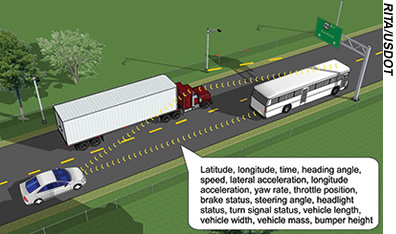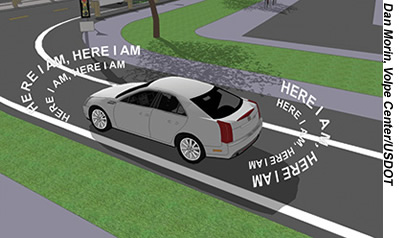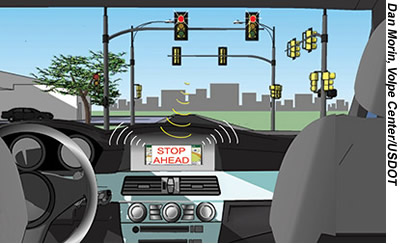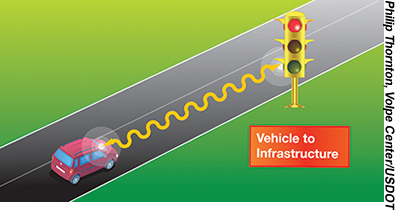Introducing the US-DOT’s Connected Vehicle Research initiative
Last updated Aug 7, 2010 — 485 views This article, by Shelley J. Row, director of the U.S. DOT’s ITS (intelligent transportation systems) Joint Program Office, introduces the IntelliDrive initiative, which is a major component of the agency’s current five-year ITS strategic research plan. The initiative aims to enhance safety, mobility, and environmental factors via wireless connectivity among ground vehicles, infrastructure, and passengers’ devices.
This article, by Shelley J. Row, director of the U.S. DOT’s ITS (intelligent transportation systems) Joint Program Office, introduces the IntelliDrive initiative, which is a major component of the agency’s current five-year ITS strategic research plan. The initiative aims to enhance safety, mobility, and environmental factors via wireless connectivity among ground vehicles, infrastructure, and passengers’ devices.
| Note: Subsequent to the initial publication of this article, the US-DOT ceased using the name “Intellidrive” for its Connected Vehicle Research program |
IntelliDrive: safer, smarter, greener
Imagine a world where automobiles and other vehicles can talk to each other in order to avoid or at least reduce the number and severity of crashes, where vehicles can communicate with traffic signals to eliminate unnecessary stops, where travelers can obtain the latest information about travel times on various modes and route options, and where transportation managers have the data to assess accurately the performance of the multimodal transportation system.
Connectivity is the key to transforming this imagined world into a real one: connectivity with and between vehicles, between vehicles and roadway infrastructure, and among vehicles, infrastructure, and passengers’ wireless devices.
These kinds of connectivity will not become available without research that is guided by a well-disciplined approach and that investigates key questions related to applications, technology, and policy. On behalf of the U.S. Department of Transportation (U.S. DOT), the Research and Innovative Technology Administration (RITA) recently released Intelligent Transportation Systems (ITS) Strategic Research Plan, 2010-2014 (FHWA-JPO-10-028), which outlines such an approach.
At the 2009 annual meeting of the Intelligent Transportation Society of America, U.S. Transportation Secretary Ray H. LaHood said, “We believe that cutting-edge ITS technologies are the key to improving highway and vehicle safety, reducing traffic congestion and CO2 [carbon dioxide] emissions, and creating a more energy-efficient, sustainable, and performance-based transportation system.”
IntelliDrive
The core of the ITS Strategic Research Plan is IntelliDrive, a U.S. DOT initiative to create interoperable connectivity among vehicles, infrastructure, and passengers’ wireless devices to produce safety, mobility, and environmental benefits. The plan focuses on key research questions related to IntelliDrive applications, technology, and policy. Research results will provide the information needed to make key decisions regarding strategies for implementing IntelliDrive.
In 2003, staff with U.S. DOT’s ITS program and others recognized that the interaction between vehicles (vehicle-to-vehicle or V2V) and between vehicles and the roadway (vehicle-to-infrastructure or V2I) holds the potential to address safety issues and other difficult transportation challenges.
V2V communication among vehicles is illustrated in this drawing of a truck, bus, and car, along with the types of data shared, as the vehicles travel on an interstate
Building from earlier ITS research (the Intelligent Vehicle Initiative — IVI), U.S. DOT launched the Vehicle Infrastructure Integration (VII) program in 2003. As the VII program progressed from the research stage into commercial testing and marketing, the researchers recognized that the scope of the ITS program needed to be expanded to explore potential applications of the newer wireless and computing technologies.
To better reflect the expanded research, in 2009 U.S. DOT rebranded the VII program as IntelliDrive. In addition, two other research initiatives — U.S. DOT’s Cooperative Intersection Collision Avoidance Systems (CICAS) and SafeTrip-21 — continue as part of IntelliDrive today.
Researchers with the CICAS program develop and test technology and applications to reduce crashes at signalized and stop-controlled intersections, including technology to enable vehicles to communicate with traffic signals to facilitate in-vehicle warnings to drivers if they are about to run a red light. At stop-controlled intersections, various technologies are being tested to give drivers who have made a legal stop information about adequate gaps in cross street traffic streams for making a movement.
SafeTrip-21 is a research initiative to adapt and test a suite of technologies available today to achieve safety and mobility enhancements in the near term. The applications include collecting fleet-based probe data from a multi-State region, using portable devices to gather traffic flow data, and providing travelers with real-time data that compare travel times on various routes and transit options.
Vehicle broadcasting “Here I Am” messages
A traffic signal and a vehicle sharing information about signal phase and timing. As the driver approaches the intersection, the traffic signal communicates a “Stop Ahead” message to the vehicle’s onboard system, alerting the driver.
Real-world tests
Under these various programs, U.S. DOT conducted a number of real-world tests. For example, the CICAS initiative conducted a pilot test of an intersection violation warning prototype in Blacksburg, VA.
In the 2007-2008 test, 87 drivers navigated a predetermined route on public roads. The route included 13 intersections with roadside communications equipment: three intersections controlled by traffic signals and 10 controlled by stop signs. The pilot test showed that the prototype was ready for larger scale field testing. The CICAS initiative has been folded into the IntelliDrive program, and any further testing will be part of the broader initiative.
In 2008 and 2009, U.S. DOT and its partners conducted a VII proof-of-concept test at specially designed test beds located in Oakland County, MI, and Palo Alto, CA. The researchers conducted these basic tests to assess the communication capabilities and characteristics of dedicated short-range communications [DSRC] radios on a 5.9 gigahertz band dedicated by the Federal Communications Commission for transportation safety purposes and designed for short-range communication among vehicles traveling at high speeds.
The tests indicated that the VII concept is feasible and uncovered additional research, technical, and policy issues that the IntelliDrive program is designed to address. Questions that need additional research and testing include whether network designs using dedicated short-range communications technology will function in a full-scale operational environment and are secure and adequately protective of user privacy.
In addition to addressing the remaining questions, U.S. DOT and its partners plan to maintain the Michigan VII test bed (now the IntelliDrive test bed) for public and private sector multimodal testing of new technologies and applications.
Research goals: safety, mobility, and environmental protection
More than 5.8 million crashes occur every year on U.S. roadways, resulting in more than 34,000 deaths annually. IntelliDrive safety applications are designed to increase situational awareness and reduce or eliminate crashes through V2V and V2I data transmission that supports driver advisories and warnings, plus vehicle and infrastructure controls. For example, IntelliDrive will expand research on V2V applications that alert a driver who is trying to change lanes if there is a car in the blind spot. Although the driver cannot see the car in either mirror due to the blind spot, these systems detect the presence of the other vehicle and warn the driver.
An example of a V2I application is an intersection violation warning application, which warns a driver who is about to enter an intersection in violation of a traffic signal. Software in the vehicle analyzes data transmitted from the vehicle and from infrastructure equipment to determine whether the driver is at imminent risk of failing to stop. If this is the case, then the traffic signal green or yellow phase could be extended to allow safe passage.
IntelliDrive safety applications have the potential to reduce crashes through advisories and warnings during imminent crash situations, such as when a vehicle ahead stops suddenly due to a road obstruction, as shown in this illustration.
With regard to mobility applications, traffic congestion is an $87.2 billion annual drain on the U.S. economy, with motorists spending 4.2 billion hours per year sitting in traffic, according to the 2009 Urban Mobility Report published by the Texas Transportation Institute. Still in the early stages of development, IntelliDrive mobility applications could combine data from a variety of wireless sources, including vehicle onboard equipment that transmits location, speed, and other operating data; infrastructure-based equipment that transmits the status of traffic control devices; and mobile devices carried by passengers that transmit anonymous location data.
Combining this information with data currently being collected by public sector agencies through loop detectors, traffic cameras, and ramp meters would provide system managers and users with detailed, real-time, dynamic data about the status of the transportation system and the vehicles using it.
Transportation managers could use this information to manage the system for optimal performance. They also could deliver the data to users to help them make more efficient or convenient travel choices. For example, real-time data about the location of all vehicles on a highway system would enable traffic managers to optimize signals to facilitate flow on a temporary detour established to route traffic away from an incident.
IntelliDrive also will provide mile-by-mile, block-by-block awareness of weather and road conditions, enabling transportation managers and travelers to make safer, more efficient decisions in adverse conditions.
In terms of environmental issues, tailpipe emissions are the single largest human-made source of CO2, nitrous oxide (N2O), and methane. Stop-and-go traffic results in 2.8 billion gallons of fuel wasted every year, according to the 2009 Urban Mobility Report. Providing motorists with real-time information about traffic congestion and other travel conditions could help them make more informed decisions that could reduce the environmental impacts of their trips.
Fuel saved due to improvements in traffic flow avoids carbon emissions and several other categories of pollutants. Informed travelers might decide to avoid congested routes, take alternate routes, use public transit, or reschedule their trips. The bottom line benefits of technologies that help reduce fuel consumption are cleaner air and water.
Through IntelliDrive applications, vehicles could “talk” to traffic signals, as depicted in this drawing, to eliminate unnecessary stops and help drivers operate vehicles for optimal fuel efficiency
Development, funding, and programs
U.S. DOT developed the research plan through a process that involved external and internal stakeholders. In spring 2009, the Department sought input from the ITS community through a request for information and an open public meeting. Using that stakeholder input, multimodal teams from within U.S. DOT developed various aspects of the plan.
The ITS Strategic Research Plan assumes that U.S. DOT’s ITS research program will receive the same level of funding as in previous years: $100 million per year for 5 years. In 2010, up to $77 million will be dedicated to ITS research, $49 million of which will be devoted to wireless connectivity. All research activities include “Go/No-Go” decision points at major milestones. At those points, U.S. DOT will assess the expected costs and benefits of additional elements of the research.
The ITS Strategic Research Plan has four main program components: IntelliDrive research, mode-specific research, exploratory research, and crosscutting support.
IntelliDrive research areas
For IntelliDrive to be implemented in the real world, research must explore and validate the effectiveness of potential applications. Included, as part of the IntelliDrive program, is research on human factors to examine how to use technology to increase safety without creating driver distraction. This research will test the most effective way to deliver information to drivers without creating unintended consequences. IntelliDrive research on applications will include V2V and V2I communications technology, real-time data capture and management, dynamic mobility applications, road weather management, and real-time information synthesis.
V2V and V2I communications technology based on dedicated short-range communications are designed to increase motorists’ awareness and reduce the number of crashes by warning them of dangerous driving situations.
Research on V2V is designed to determine the safety and effectiveness of V2V applications so that the National Highway Traffic Safety Administration (NHTSA) can decide whether to pursue a rulemaking process to require or encourage this technology on some or all vehicles. For V2I safety research, an initial focus will be applications that communicate traffic signal phase and timing information to vehicles. All of the V2V and V2I research will examine the potential use of aftermarket devices to expedite in-vehicle capabilities, plus the amount and type of infrastructure needed to support the applications.
- Real-time data capture and management research — will create and expand access to high-quality multimodal transportation data captured from connected vehicles, mobile devices, and infrastructure.
- Dynamic mobility applications research — will identify transformative applications and innovative methods to manage and operate transportation systems based on the availability of new data sources and communications methods. The goal is to develop applications that can provide travelers and system operators with greater access to real-time information about the transportation system to facilitate improved decision making.
- Road weather management research — will consider how travelers and transportation agencies can use vehicle-based data on current weather and road conditions to make decisions that take into account those conditions and forecasts. This data can supplement data from existing road weather information systems and can be used to better manage winter maintenance activities and enhance weather-related traveler information.
- Applications for the Environment: Real-Time Information Synthesis (AERIS) research — focuses on the capture, synthesis, and delivery of real-time, vehicle- and infrastructure-based, environmentally relevant information to support system management that advances environmental improvements within the transportation system, including protection of air and water quality. Still in the early stages of development, the AERIS research program is intended to generate, capture, and analyze data to create actionable information that allows system users and operators to make green transportation choices, such as which travel modes and routes offer the most environmentally friendly path to a destination and how to operate traffic signals and other system elements to reduce vehicle emissions.
Mode-specific research
Mode-specific research includes active traffic management, international border crossings, roadside infrastructure for commercial vehicle operations, expansion of the Commercial Vehicle Information Systems and Networks program, multimodal integrated fare payment systems, and maritime applications.
Exploratory research
Exploratory research consists of a rail exploratory initiative, which will investigate the application of IntelliDrive technologies within the rail environment, and an exploratory research solicitation through which U.S. DOT will work with the research community to identify other promising technologies and applications.
Crosscutting support and next steps
The plan also includes crosscutting activities that will serve as a foundation for implementation of the research results. Among the crosscutting activities is research on nontechnical questions needed to establish the basis for wide-scale deployment, such as defining deployment scenarios, determining financing and governance options, and identifying means of addressing liability, privacy, data ownership, and other institutional issues.
Also needed are the harmonization of standards and a common system architecture, as well as certification processes for the most critical safety technologies. International cooperation and coordination are important aspects of the new strategic plan. In a recently signed joint declaration of intent, U.S. DOT and the European Union agreed to work together on common elements of the research, including selected applications, harmonization of international ITS standards, and shared testing tools and methodologies.
The objective is to work with the international standards community to increase vehicle connectivity. Harmonization facilitates interoperability among products and systems, which benefits transportation management agencies, vehicle manufacturers, equipment vendors, and other stakeholders. Overcoming institutional and financial barriers to technology harmonization could enable stakeholders to realize lower life-cycle costs for the acquisition and maintenance of systems.
Next steps relate to research on applications of new technologies and validation of the benefits of those technologies, determination of the minimum infrastructure needed to be functional, and research on the degree of market penetration required for the system to have the desired effect. Technical questions concern the stability, reliability, security, and interoperability of the new technologies, and the availability of international standards to ensure interoperability. Policy questions involve the policies, governance, and funding required to ensure sustainability and privacy, while avoiding driver distraction.
Although the strategic plan, which was released in December 2009, establishes an overall vision and broad areas of research, it does not define the details of how the research will be executed. U.S. DOT is developing a more detailed plan in coordination with various internal and external stakeholder groups, and will release that plan in the summer of 2010.
“Developed with strong stakeholder input, the ITS Strategic Research Plan outlines a vision for a national, multi-modal surface transportation system that will lead to unprecedented safety, mobility, and environmental sustainability, while sparking countless other commercial applications of ITS technologies,” says RITA Administrator Peter Appel.
To learn more about the U.S. DOT’s IntelliDrive initiative, read the IntelliDrive whitepaper (pdf file).
About the author: Shelley J. Row has been director of U.S. DOT’s ITS Joint Program Office since 2007. Previously, Row worked in FHWA’s division offices in Arizona, California, and North Carolina. She also served as engineering systems manager in the Georgia Division Office, where she was responsible for ITS project implementation in preparation for the 1996 Olympic Games. In 2000, Row became director of FHWA’s Office of Transportation Operations. She holds bachelor’s degrees in civil engineering and architecture from Texas Tech University and an MBA in management from Virginia Tech.
Article source: This article originally appeared in the U.S. DOT Federal Highway Administration’s July/August 2010 issue of “Public Roads,” and has been reproduced here with permission.




